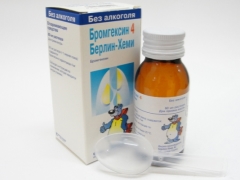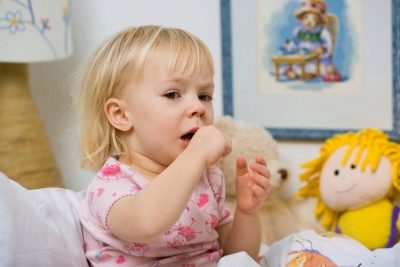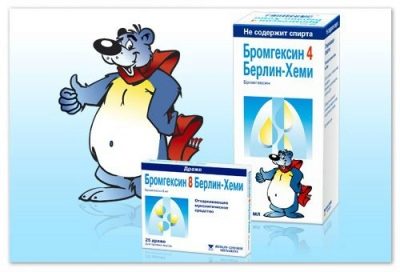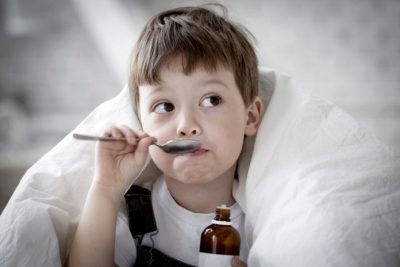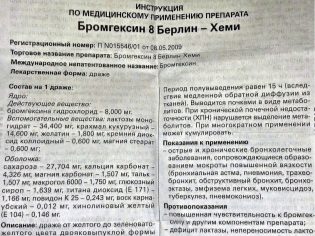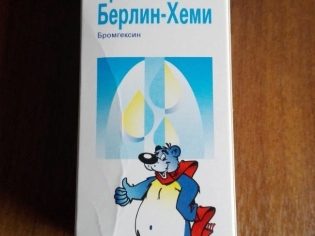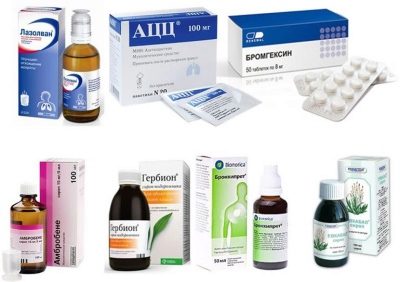Bromhexine for children: instructions for use
In the treatment of cough, mucolytics are among the most sought-after drugs. One of the representatives of this group of drugs is Bromhexin. Can children be treated with Bromhexin and in what dosage is it permissible to use it in childhood?
Release form
In the assortment of pharmacies Bromhexin is presented in several forms:
- Syrup. This popular treatment for children Bromhexine produced by various pharmaceutical companies, including Akrikhin, Grindeks, Rosepharm, Pharmstandard leksredstva and others. Such a sweet, viscous liquid is usually sold in bottles of 100 ml.
- Solution. In this form, Bromhexin is offered by the German company Berlin Hemi, the domestic manufacturer Atoll, the Indian company Simpex Pharma, the manufacturer from Denmark Nycomed and others. The medicine is a palatable liquid that is ingested. In addition, this form of Bromhexine can be used for inhalation. One bottle of this solution most often contains 100 ml of medicine, but bottles of 60 or 150 ml are also sold.
- Pills. Depending on the dosage, they are divided into tablets for children and for adults. This form of Bromhexine is represented in the assortment of Biosintez, Atoll, Grindeks, Medisorb, Akrikhin and many others. One pack contains from 10 to 100 tablets.
- Dragee Such Bromhexin is produced by the company Berlin-Chemie and is represented by yellow-green dragees in a package of 25 pieces.
Composition
The main compound in any Bromhexine, due to which the medicine has medicinal properties, is represented by Bromhexine hydrochloride. Its amount in 5 ml of liquid preparation or 1 tablet is 4 mg or 8 mg. Depending on the form of the drug and the manufacturer, the composition of the excipients will be different, so it should be specified from the abstract attached to the package. Additional ingredients are ethyl alcohol, sucrose, sorbitol, lactose, propylene glycol, flavors, wax and many other compounds.
Operating principle
Reception of Bromhexine affects mucoproteins and mucopolysaccharides in the composition of mucus produced in the bronchi. As a result of this action, sputum viscosity decreases and its volume increases.. The drug has expectorant and unexpressed antitussive effect, which causes its demand when coughing. In addition, the reception of Bromhexine has a positive effect on the synthesis of surfactant.
Natalya Fedorovna Chernega, Chief Physician of the Pediatrician and I Medical Center Pediatrician, PhD, Senior Researcher of the Department of Nutrition and Somatic Diseases of Young Children of the State Institution, tells about the peculiarities of the use of mucolytics in children, which is the Bromhexin preparation. Pediatrics, Obstetrics and Gynecology NAM. "
Indications
Bromhexine is prescribed for various pulmonary diseases, accompanied by the formation of very viscous sputum. The drug helps cough up a secret for bronchitis, pneumonia, asthma, cystic fibrosis, tuberculosis damage, bronchiectasis and other diseases of the respiratory tract.
At what age is it allowed to take?
In pediatric practice, Bromhexine is used from birth.however, this medication is prescribed to children under 2 years old with extreme caution and only under the supervision of a specialist. Low dosage tablets (4 mg) are allowed from 3 years of age, and tablets and 8 mg of Bromhexine tablets are indicated for children over 6 years of age.
Contraindications
Bromhexine is not prescribed in case of detection of hypersensitivity to its components, for example, to the active substance or lactose in tablets. Also It is impossible to treat Bromhexin of the child during exacerbation of diseases of the digestive tract. If a small patient has a kidney disease or any liver disease, Bromhexine should be prescribed carefully, monitoring the child’s condition throughout the treatment.
Side effects
- Due to treatment with Bromhexine, dyspeptic symptoms are possible.
- Taking this medicine in some children provokes headaches as well as dizziness.
- The consequence of Bromhexin therapy may be a temporary increase in the activity of liver enzymes.
- Some patients are allergic to Bromhexine.
- In bronchial asthma, the drug may cause increased cough due to bronchospasm, so the presence of asthma in a child requires careful use of Bromhexine.
Instructions for use and dosage
Syrup, solution, pills or dragees are taken orally, regardless of the meal three times a day. A single dose of the drug is determined by age:
- A child under two years old is given 2 mg of the active ingredient. Treatment of young patients of this age is carried out only under the supervision of a pediatrician. Bromhexine babies up to 2 years of age are prescribed only in syrup or solution. Usually 2 mg is contained in 2.5 ml of this form of medicine.
- A child aged 2-5 years at a time give 4 mg of Bromhexine. This amount of active compound is contained in 5 ml of solution or syrup, as well as in 1 tablet for children. Tablet form is offered to children over 3 years old, able to swallow tablets.
- A child aged 6 to 10 years for 1 admission need 6-8 mg of bromhexine. This amount of active compound can be obtained by a small patient both from liquid forms and from any solid forms.
- For children over 10 years old, a single dose is 8 mg of the active substance. At this age, it can be obtained from any form of Bromhexine, but the most convenient way is to use dragees and 8 mg tablets, because for 1 administration you need only 1 such tablets or 1 tablet.
When indicated, the pediatrician may increase a single dose of Bromhexine to 16 mg per dose. The duration of treatment is influenced by various factors, but minimally the medication is prescribed for 4 days. (this time is required to obtain a therapeutic effect), and the maximum duration of therapy usually does not exceed four weeks.
Inhalations with a Bromhexine solution prescribed by a pediatrician are carried out twice a day using a nebulizer. At the age of 6-10 years for one procedure, use 2 mg of the drug (corresponding to 2.5 ml of solution), and for children over 10 years old - 4 mg (contained in 5 ml of solution). For children under six years of age, the dosage is set by the doctor.
Bromhexine preparation commercial:
Overdose
If a child accidentally drank a large dose of syrup or many Bromhexine tablets, it will lead to vomiting, severe nausea, and other disorders of the digestive tract. Finding an overdose immediately (within a maximum of two hours after the incident), you need to flush the stomach with artificially induced vomiting, and then give the child a lot of drinking.
Interaction with other drugs
Bromhexin goes well with drugs that expand the bronchi, as well as with many antibacterial drugs. But the combination of this medication with antitussive drugs is undesirable. Due to the oppression of the cough reflex, such a combination of drugs will adversely affect the patient's condition and cause sputum stagnation in the bronchi.
Terms of sale
All drugs on the basis of Bromhexine are non-prescription drugs, therefore, freely sold in pharmacies. The cost of a particular medication is affected by its form, and the manufacturing company. For example, the price of a bottle of 100 ml of Grindex syrup is about 130 rubles, and a bottle of 60 ml of Bromhexin 4 Berlin-Chemie costs an average of 170 rubles. Prices for a package of 20 tablets containing 8 mg of Bromhexine vary from 20 to 50 rubles.
Storage conditions and shelf life
Bromhexine tablets, syrup or other form should be kept away from moisture and sunlight. In addition, the preparations should not be freely accessible to young children. The storage temperature of drugs with bromhexine should not exceed +25 degrees.
The shelf life of different forms is different. It can be either 2 or 3 years, or 5 years or even 7 years. In some solutions and syrups, such a period after opening the bottle is reduced to several weeks, therefore, information on the storage of the selected Bromhexine should be specified separately.
Reviews
The use of Bromhexine in the treatment of cough in children respond mostly well. Parents confirm the relatively high effectiveness of the tool and help in the dilution of sputum. At the same time, syrups are more often chosen for treatment, since children like their taste, and it is more convenient to dose this medicine. Solutions are equally in demand, because they can be used for inhalation. According to reviews of moms, the side effect of Bromhexine is rare, and if the children's organism reacts to the drug with negative symptoms, then after withdrawal they immediately disappear.
Analogs
Instead of Bromhexine, a child can be given other medications to help with a dry or wet cough. Replace bromhexin able to:
- Drugs with the same active compound, for example, Bronchotil syrup, Solvin tablets or Bronkhostop syrup.
- Ambroxol based products. These drugs are Ambrobene, Bronchus, Ambrohexal, Ambrosan, Lasolvan, Flamed other.
- Herbal remedies for cough. These include Gidelix, Althea Syrup, Dr. Mom, Prospan, licorice syrup, PertussinPectolvan Herbion, Mukaltin and other drugs.
- Combination Drugs, one of the components of which is Bromhexine. Such means are Ascorilsyrups Joset or Kashnol, drops Bronkhosan and others.
It is important to note that any of these drugs has its own characteristics of use, so it is recommended to choose an analogue of Bromhexin together with a doctor.
Be sure to watch the release of the program of Dr. Evgeny Komarovsky, dedicated to the problem of children's cough. From it you will learn a lot of useful things:
